Key takeaways:
- The breakdancing community fosters deep connections through shared experiences, emphasizing both competition and collaboration.
- Emotion is a vital aspect of dance, allowing dancers to express complex feelings and create a strong bond with their audience and fellow performers.
- Movement serves as a powerful form of emotional expression, where different emotions can influence a dancer’s style and technique.
- Building a supportive network within the dance community encourages creativity, collaboration, and personal growth among dancers.
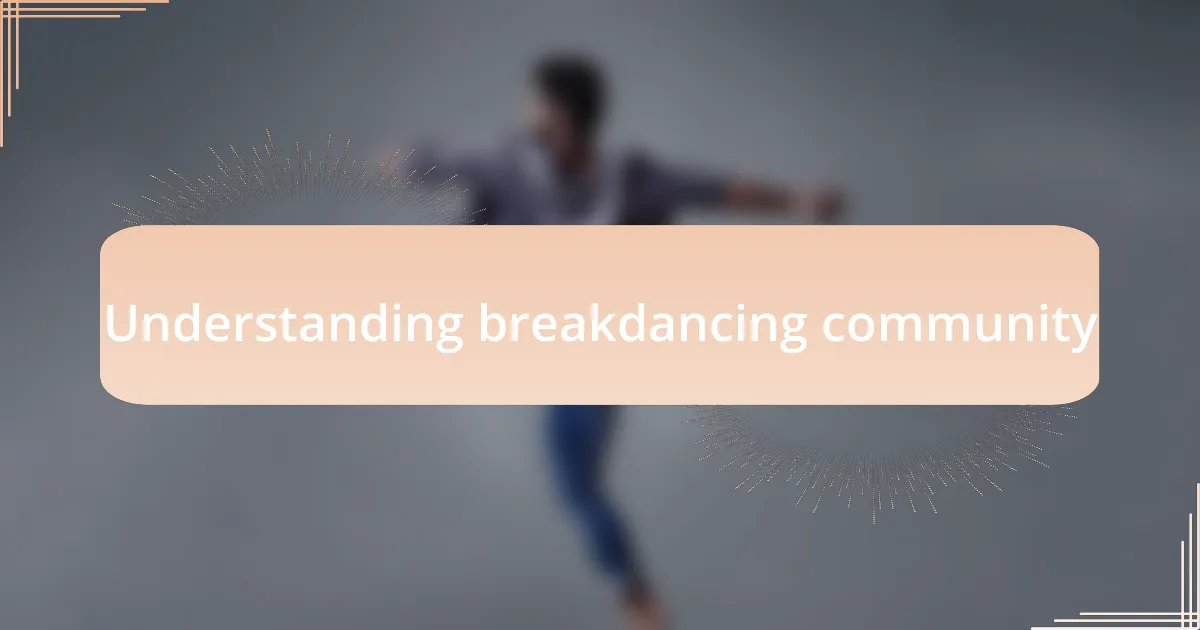
Understanding breakdancing community
The breakdancing community is more than just a group of dancers; it’s a vibrant tapestry woven from diverse backgrounds and shared passions. I remember my first jam, feeling the energy crackling in the air as dancers took turns showcasing their unique styles. Each movement felt like a conversation—a way to express not just skill, but identity and emotion.
As I’ve participated in events over the years, I’ve come to appreciate the deep kinship among b-boys and b-girls. Whether we’re supporting each other during battles or celebrating each other’s progress, there’s an undeniable bond that forms through our shared love for dance. Have you ever felt that connection in a community you’re passionate about? It’s a feeling that keeps me coming back, knowing I belong to something bigger than myself.
It’s fascinating to see how this community thrives on both competition and collaboration. While battles can be intense, they often serve as a catalyst for learning and growth. I recall moments of defeat, but even those felt welcoming when surrounded by friends who uplifted each other, turning setbacks into stepping stones. Isn’t that what truly defines a community? The ability to rise together, learning from our shared experiences, makes breakdancing a powerful force for connection.
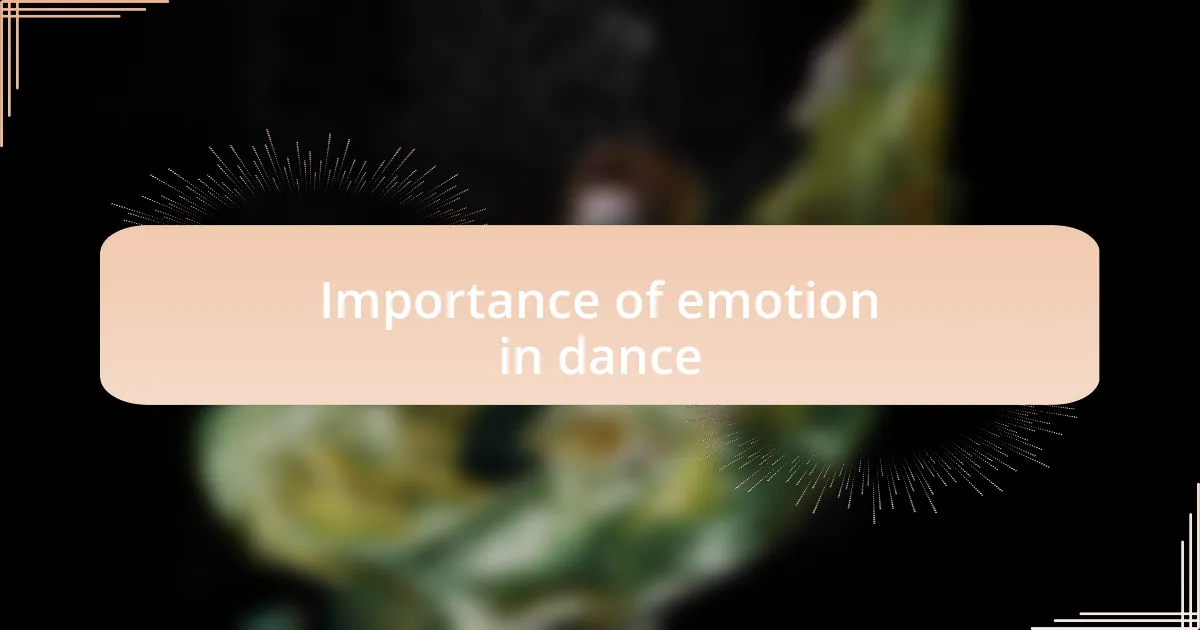
Importance of emotion in dance
Emotion plays a pivotal role in dance, particularly in breakdancing, where every move can convey a profound message. I remember witnessing a b-girl perform, her face illuminated with passion, and it struck me how her emotions transformed basic moves into something extraordinary. Have you ever watched a dancer and felt as if you were witnessing their story unfold? That emotional connection not only captivates the audience but also brings life to the choreography.
In my experience, the power of emotion in dance transcends technical ability. I once had a moment during a freestyle session where I was completely lost in the music; it felt like my body was moving of its own accord, expressing feelings I couldn’t articulate in words. That raw, unfiltered joy of expressing myself through movement is something every dancer should experience. Isn’t it incredible how dance can become a language of its own, capable of expressing what we sometimes can’t?
Engaging with emotion can also enhance the connection between dancers during a performance or battle. I vividly recall a cypher where two dancers faced off, both so deeply invested in their movements that the audience held its breath. The intensity of their shared experience created an electrifying atmosphere, reminding me of the unspoken bond that forms through shared emotional expression. This interplay not only fuels the dance but also enriches the community, allowing us all to resonate with one another on a deeper level.
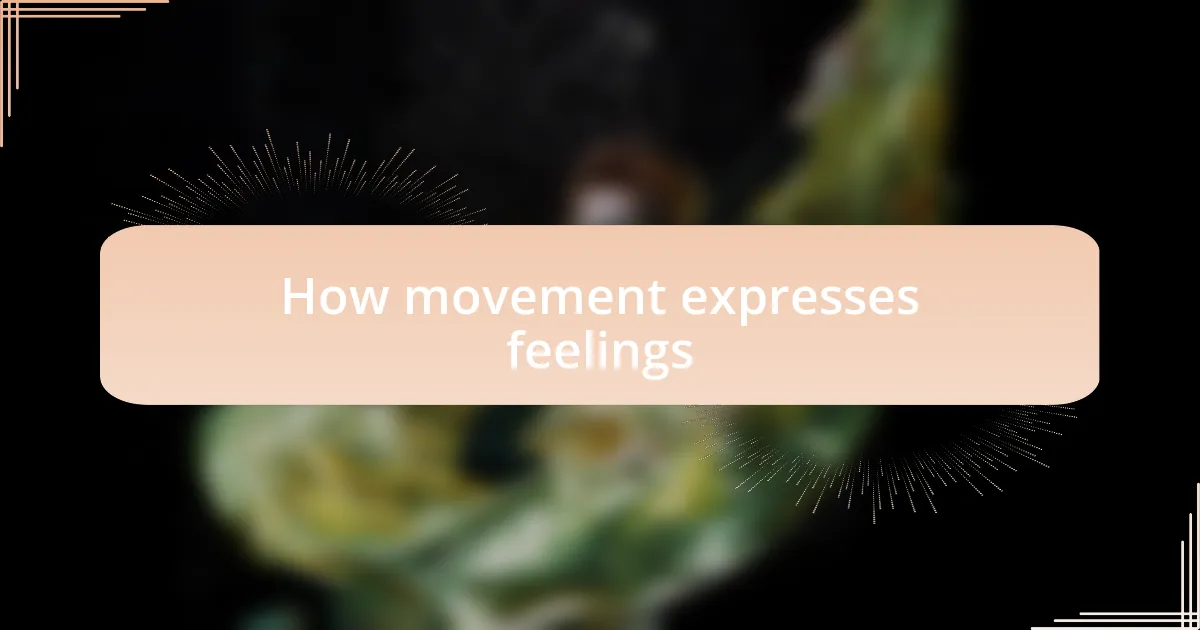
How movement expresses feelings
Movement can be a powerful vehicle for emotions, often speaking louder than words. I find this especially true when I watch a dancer channel their energy into intricate footwork or graceful spins. The way their body responds to the rhythm and the beat can tell a story of happiness, frustration, or even heartbreak. Have you ever felt the energy shift in a room when a dancer performs their routine with raw emotion?
In breakdancing, the nuance of each gesture can reflect a dancer’s inner landscape. I remember battling in a local event, feeling the adrenaline surging through my veins. Every spin and freeze felt like a release of pent-up feelings, each move articulating what I couldn’t express otherwise. It’s fascinating how an isolated movement, like a headspin or a power move, can encapsulate a complete emotional experience, transforming the dance floor into a canvas of personal expression.
What strikes me most is how different emotions can influence the style and execution of breakdancing. When I’m dancing out of joy, my movements are sharper, more explosive. Conversely, when I’m grappling with sorrow, my shifts may feel heavier, more grounded. Have you noticed how your mood affects your movement choices? This intrinsic link between emotions and the physicality of dance is what makes it such a captivating art form and a profound way to connect with ourselves and each other.
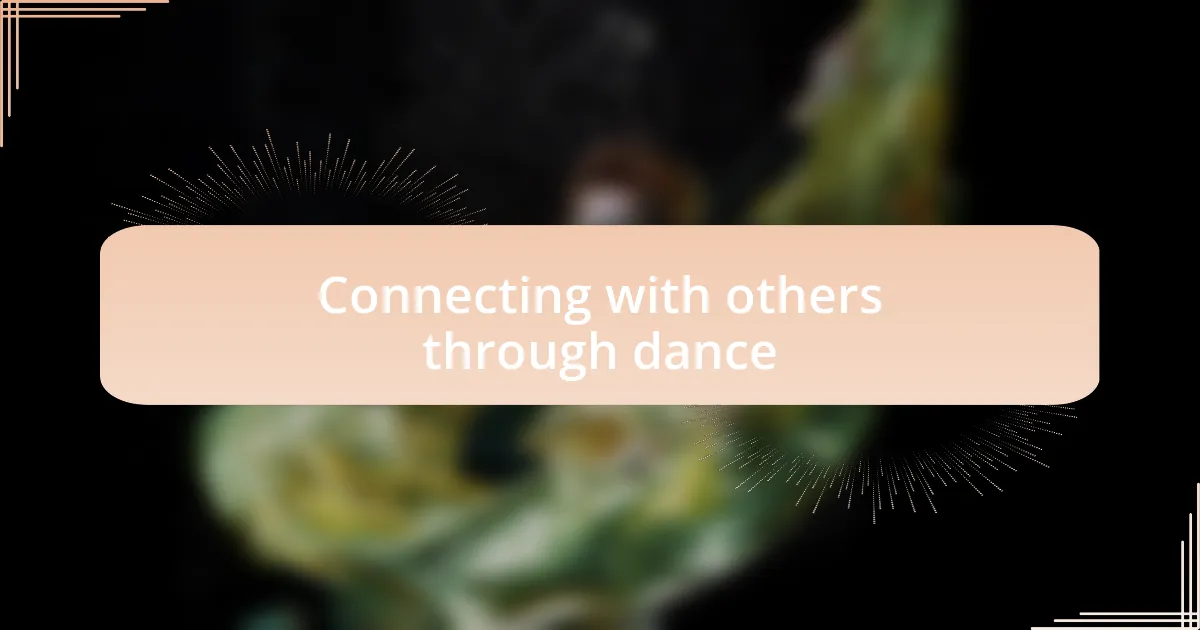
Connecting with others through dance
When I step onto the dance floor, I often feel a distinct connection with fellow dancers, as if we are sharing a silent conversation through movement. In a recent jam session, I found myself locked in an exchange with another breaker; his smooth transitions mirrored my own, creating an unspoken bond that felt electric in the air. Have you ever felt that spark, where the rhythm pulls you closer to someone else, and suddenly, it’s like you’re both on the same wavelength?
The power of breakdancing lies not just in individual expression but in the collective vibe we create as a community. I vividly recall a time when a spontaneous circle formed at a local event; dancers from different backgrounds joined in, each bringing their own flavor to the mix. It was incredible to witness how our unique styles interwove, highlighting the beauty of diversity while forging connections that were deeply felt. Isn’t it amazing how dance can break barriers and bring people together, even when words fail us?
In those moments, the energy in the room shifts, igniting a sense of belonging that resonates with every move. I often reflect on how sharing these emotional exchanges through dance strengthens our ties, reminding us that we’re not alone in our struggles or triumphs. Have you ever experienced the beauty of unity on the dance floor, where everyone loses themselves in the music and movement, feeling that shared pulse of life together?
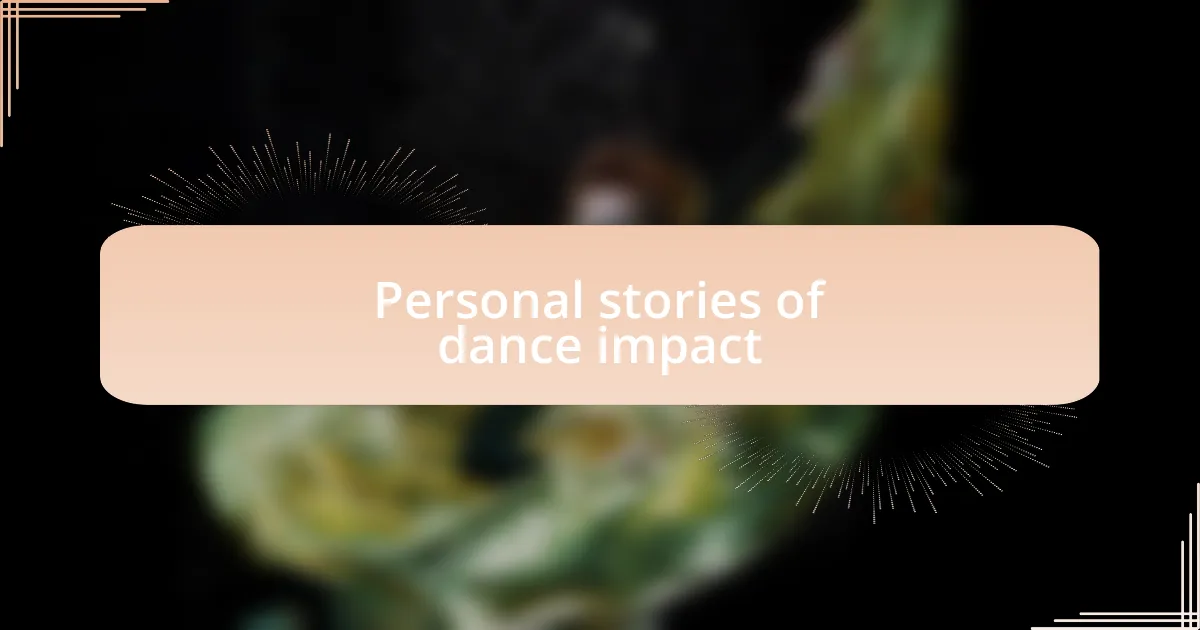
Personal stories of dance impact
I remember a night that changed everything for me. While practicing in my garage, I invited a few friends to join. As we exchanged our styles, I noticed how our laughter filled the space, transforming a simple practice into a memorable experience. It struck me that in those moments, dance wasn’t just about perfecting moves; it was about sharing joy and creating memories together. Have you ever felt the warmth of laughter blending with rhythm, where every kick and spin ignites a new kind of happiness?
At another event, I met a young dancer struggling with self-doubt. As I showcased my routine, I felt compelled to let him know how I had once been in his shoes. After sharing a few of my initial stumbles, I saw his eyes light up. It was a profound moment—dance had become our bridge. Isn’t it fascinating how our personal journeys can uplift others, even in the most unlikely settings?
The energy in his movements changed after that night. He seemed more confident, more alive, as if he had unlocked something within himself. I can’t help but think about how dance creates a safe space to explore vulnerability. Have you ever seen the transformation of someone blossoming through movement, where their emotions surface and their spirit shines? Such moments remind me that our stories, woven together in often-unseen ways, shape the dance community we cherish so deeply.
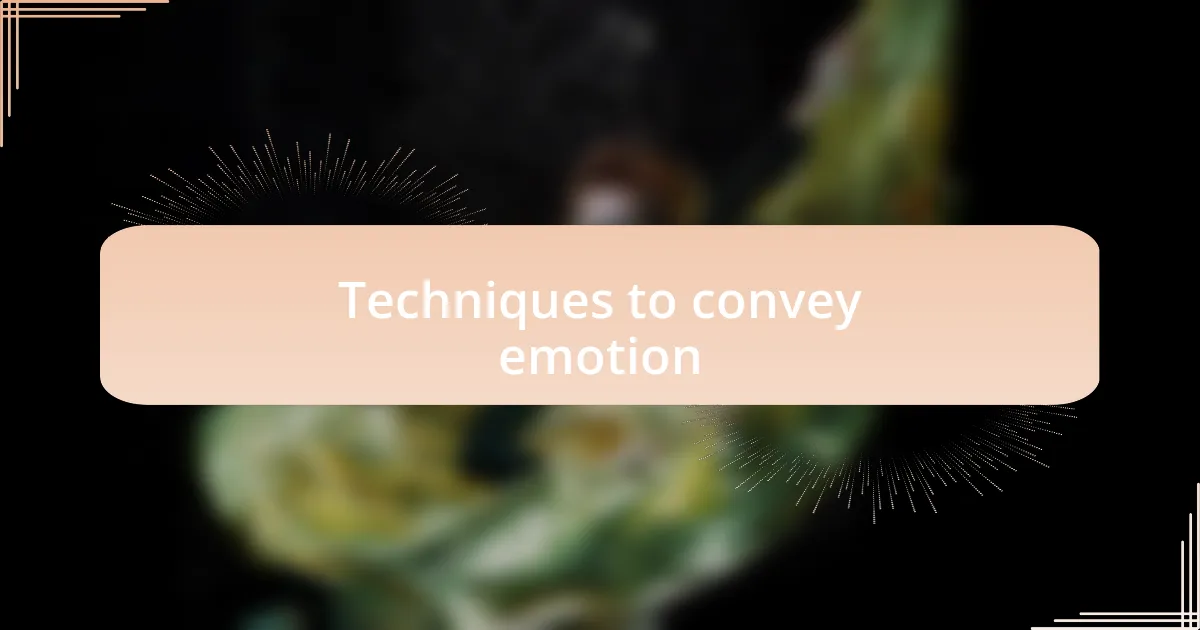
Techniques to convey emotion
When I perform, I often focus on the subtleties of my movements to convey emotions that words cannot express. For instance, I might use slow, deliberate motions to communicate a sense of longing, while sharp, dynamic transitions can evoke excitement or urgency. Have you ever noticed how the tempo of your music influences your flow? It’s incredible how a simple shift in beat can transform your whole energy on stage.
In those moments where I feel a wave of emotion, I apply the technique of mirroring—reacting to the energy of those around me. Once, during a cypher, I locked eyes with another dancer who was pouring their heart out through their freestyling. I instinctively matched their intensity, reflecting their emotions back in my own style. It created a profound connection between us. Isn’t it interesting how our bodies can tap into the collective vibe, amplifying what we’re all feeling?
Another powerful technique I’ve embraced is storytelling through my movements. Each time I perform, I envision a narrative that aligns with the music, almost like I’m playing a character. There was a time when I interpreted a song about resilience, and with every spin and freeze, I imagined overcoming obstacles. The audience responded with a similar sense of catharsis. How do you weave your own experiences into your dance, enhancing not just your expression but also that of those watching? It’s moments like these that remind me that emotion in movement is about connection—both personal and communal.
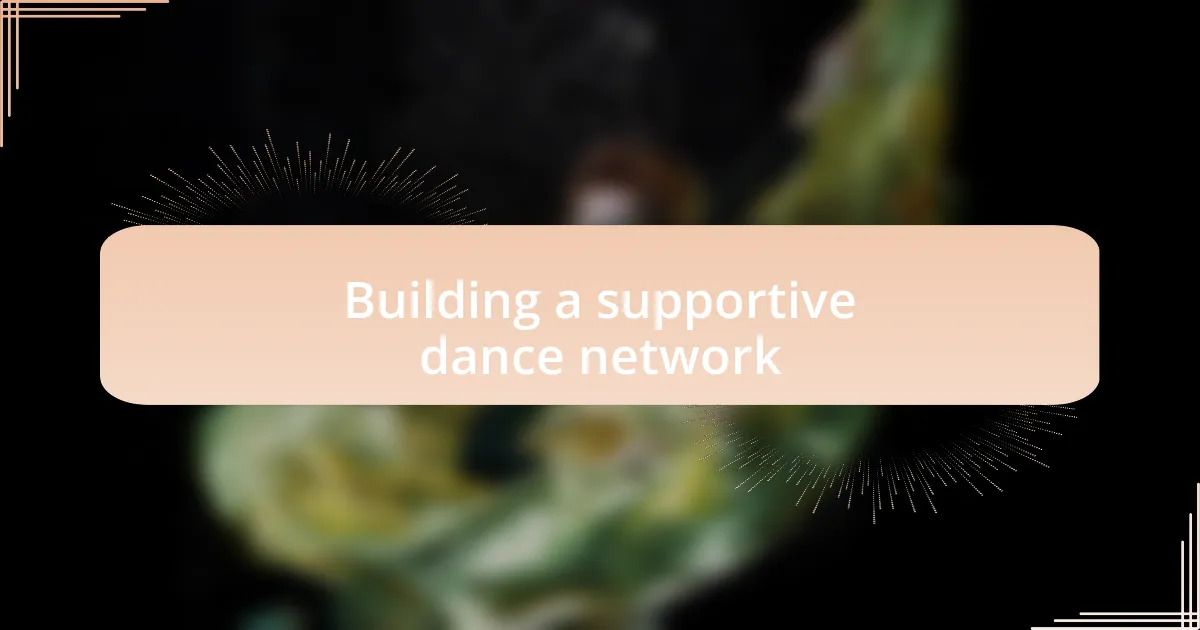
Building a supportive dance network
Building a supportive dance network is crucial for fostering creativity and collaboration among dancers. I remember attending a local jam where experienced dancers took the time to guide newcomers, offering constructive feedback rather than criticism. It transformed the atmosphere; suddenly, everyone felt encouraged to step outside their comfort zones. How can we create environments where we uplift one another instead of competing fiercely?
One powerful way to build this network is through regular practice sessions and open workshops. When I started organizing these gatherings, I was amazed how they nurtured friendships and trust within the community. Not only do we improve our skills, but we also share our struggles and victories, creating a sense of shared experience that strengthens our bonds. Have you ever felt that lift in morale just by being around fellow dancers?
Ultimately, we can all play our part in cultivating a space where everyone feels valued and heard. Sharing resources like training videos or offering to partner up for practice can make a world of difference. For me, this supportive dynamic served as a launchpad for growth, allowing us to connect not just through dance but through our shared passion for expressing emotion and storytelling.